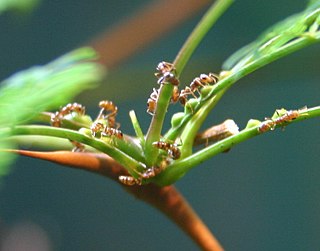
The Sri Lankan elephant is one of three recognised subspecies of the Asian elephant, and native to Sri Lanka. Since 1986, Elephas maximus has been listed as endangered by IUCN as the population has declined by at least 50% over the last three generations, estimated to be 60–75 years. The species is primarily threatened by habitat loss, degradation and fragmentation.

Senegalia ferruginea is a species of plant in the family Fabaceae. It is found in India and Sri Lanka.
Cullenia rosayroana is a species of flowering plant in the family Malvaceae. It is endemic to Sri Lanka.

Calophyllum tomentosum is a species of flowering plant in the family Calophyllaceae, commonly known as bintangur. It is found in Sri Lanka and the Western Ghats.
Calophyllum walkeri is a species of flowering plant in the Calophyllaceae family. It is found only in Sri Lanka. It is reddish brown with dark streaks and is a strong, durable wood. It is used for beams, rafters, posts & door frames. It weighs about 46 lbs per cubic foot. It can be found in hill country in Sri Lanka. The leaves and bark have fragments. It is known as කින (Kina) in Sinhala.

Archidendron bigeminum is a tree species in the legume family (Fabaceae). It is found in India and Sri Lanka. It is known as "Kalitiya - කලටිය" in Sinhala people.
Clinothelphusa kakoota is a species of crab in the family Gecarcinucidae, which is endemic to Sri Lanka. Its natural habitats are subtropical or tropical moist lowland forests, subtropical or tropical swamps, and rivers. It is threatened by habitat loss, and is listed as a critically endangered species on the IUCN Red List. It is known from a single site with an area of less than 100 km2 (39 sq mi). Its nearest relatives are another Sri Lankan endemic genus of crabs, Ceylonthelphusa.

Canarium zeylanicum is a species of flowering plant in the frankincense family, Burseraceae, that is endemic to Sri Lanka. Canarium zeylanicum is a large branched tree that can grow up to 25–30m in height. The seeds of this plant are large, oval, and they can be eaten. This plant can be seen with fruits and flowers in the months of April to September. The oil of the seeds of Canarium zeylanicum are edible and this oil has been used by Sri Lankans for medicinal purposes and for food for ages. However, these uses of the plant are confined to its rural population and even then, they mostly use it for traditional medicinal purposes. Over 95% of the seeds produced and harvested from these plants are thrown away, wasting its source of valuable, natural, and nutritional value.
Memecylon gardneri is a species of plant in the family Melastomataceae. It is endemic to Sri Lanka.
Memecylon giganteum is a species of plant in the family Melastomataceae. It is endemic to Sri Lanka.

Prunus ceylanica is a species of plant in the family Rosaceae. It is a resident species to Sri Lanka and India.
Syzygium makul is a species of plant in the family Myrtaceae. It is endemic to Sri Lanka.
Syzygium rotundifolium is a species of plant in the family Myrtaceae. It is endemic to Sri Lanka.
Cinnamomum citriodorum is a species of flowering plant in the family Lauraceae. It is endemic to Western Ghats and Sri Lanka. It is commonly known as Malabar Cinnamon. It has a characteristic smell of lemon grass. C. citriodorum has 45% Cinnamaldehyde compared to 80% for C. cassia.
Wildlife of Sri Lanka includes its flora and fauna and their natural habitats. Sri Lanka has one of the highest rates of biological endemism in the world.

Caesulia is a monotypic genus of flowering plants in the aster family, Asteraceae, containing the single species Caesulia axillaris. Its common name is pink node flower. It is native to Bangladesh, Burma, India, Nepal, and Sri Lanka.

Climate change in Sri Lanka is an important issue, and its effects threaten to impact both human and natural systems in Sri Lanka. Roughly 50 percent of its 22 million citizens live in low-lying coastal areas in the west, south, and south-west of the island, and are at risk of future sea level rise. Climate change also threatens the island's biodiversity, including its marine ecosystem and coastal coral reef environments. Sea-level rise due to climate change has the potential to affect the overall abundance of endemic species. Sri Lanka's coastal regions, such as the Northern Province and the Northern Western Province, are considered major hotspots and extremely vulnerable to climate change. These maritime provinces are the most densely populated. In addition to being a threat to Sri Lanka's biodiversity, climate change may cause disastrous consequences on various levels in such areas. Such consequences include: Affecting agricultural productivity, causing natural disasters like floods and droughts, increasing the spread of infectious illnesses, and finally undermining the living standards.
Garcinia terpnophylla is a species of flowering plant in the Clusiaceae. It is found only in Sri Lanka where it is known as කොකටිය (kokatiya) in Sinhala.
Diospyros quaesita or calamander is a species of tree endemic to Sri Lanka. in Sinhala, this tree is called kalu mediriya. This large tree occurs in the evergreen forests of lowland wet zones. This tree is found in 25 forest sites.








